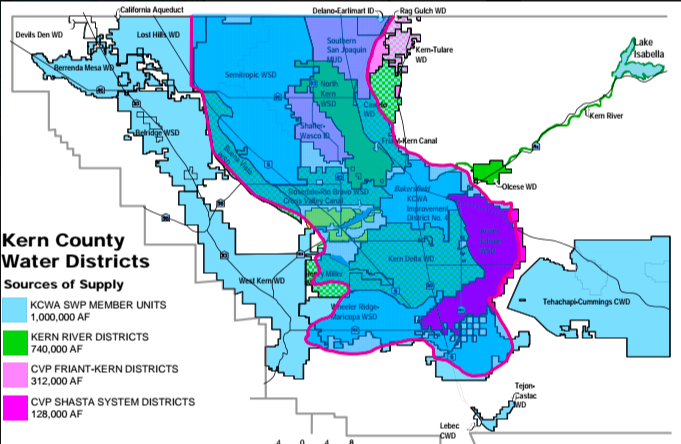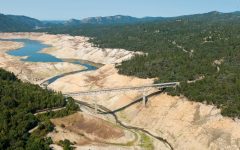
San Luis Reservoir, Feb. 16, 2025. (Photo: Katy Grimes for California Globe)
State Water Board Held Hearing Concerning Placing Kern Subbasin Under Probation, Part I
Probation means the State Board would take over the subbasin’s SGMA management
By Don Wright, February 25, 2025 9:31 am
The State Water Resources Control Board, State Board, held a hearing concerning placing the Kern Subbasin under probation for not having an adequate Groundwater Sustainability Plan (GSP) under the Sustainable Groundwater Management Act (SGMA). The hearing was held Thursday, February 20, 2025 at the California EPA building in Sacramento and online. It was scheduled to commence at 9:00am. It was a very long meeting and the original report was correspondingly long. Fear not, we’ve broken it down for you. This is part one of three parts.
The agenda called for comments by elected officials or tribal spokes folks first. After that the State Board staff would give its presentation, the Kern Subbasin representatives will convey a panel and then the public can comment. After all the board will ask questions and perhaps vote.
The State Board staff has prepared two resolutions. The first would set the Kern Subbasin in probation. This means the State Board would take over the subbasin’s SGMA management. An alternate resolution would be to extend the decision and give the players in the subbasin more time to further address deficiencies in the GSP. Once the GSP is deemed adequate by the State Board staff the Kern Subbasin would be interacting with the Department of Water Resources, with far less draconian regulatory pressure.
The staff was giving everyone a reminder of how SGMA works and why the State Board would take over from the Department of Water Resources. Staffer Tina Leahy explained the first option to place Kern into probation. She said there are exclusion provisions for a Groundwater Sustainability Agency, GSA from being placed into probation. A GSA would have to have its portion of the GSP pass review for compliance.
Natalie Stork said there are no GSAs in the Kern Subbasin that meets the exclusion criteria. A masked man named Anthony reported if the board chooses probation well location, capacity, monthly extraction volumes and the place purpose of the pumping will have to be reported to the State Board beginning June 1st. If a pump extracts more than 500 a/f annually it will have to have a certified meter. The usual meter cost is between $3,000 and $5,000. In addition each well will be charged $300 annually and there will be a $20 per a/f extraction fee.
Anthony said option two would continue the decision until September 17th provided a new draft of the GSP correcting deficiencies meets a June 20th deadline. It was said State Board staff will continue to work with the GSAs and continue evaluating the revised GSPs. There is no time frame for this action, it can go on and on until the State Board determines the GSP is adequate. However, if this isn’t resolved within one year the State Board can impose its own GSP.
Chairman Joaquin Esquivel asked tribal members to weigh in. Octavio Escobedo III, Tejon Tribe said the Tejon’s are the only recognized tribe in the subbasin. He asked the State Board to not place the Kern Subbasin in probation as it will harm the tribe’s plan to build a new casino and fire station for the reservation. He said working with the Arvin Edison Water Storage District has been providing much help and probation could harm that. There was then a 10-minute break.
Kern Presentation
Derek Yurosek, a Director on Arvin Edison WSD began the presentation touting the efforts to bring about a successful SGMA compliance. The other panel members were all engineers from the technical side of the plan development. Lead Consulting Engineer Anona Dutton said the final plan under consideration today is a multimillion-dollar, Herculean accomplishment.
Dutton said the subbasin is 1.782 million acres, the largest in the state. Forty of the 71 approved basins could fit within its borders. Within the subbasin 657,000 acres, the majority of the farmland irrigated has access to surface water supplies. 920,000 acres are native, idle or under conservation. It also has 91,000 acres of oilfields and one of the fastest growing cities in the state, Bakersfield.
Dutton said the goal for the plan is to implement multiple layers of protection for beneficial users. The sustainable management criteria, exceedance policy, well mitigation program and projects and management actions are included to ensure protection from undesirable results and achieve sustainability. At this point in the meeting all of the presentation slides displayed on the very large screens in the hearing room forgot English. Only Spanish and Punjabi language slides would appear. So, that took a bit of messing around to get it going again. But once that was sorted out. . .
Dutton continued saying it took six individual plans and whipped it into one unified GSP. This is the result of commitment coordination, including demand management – a term for reducing acreage farmed and extensive stakeholder and public engagement in the process. It was only March of 2023 when DWR found the GSP inadequate. Since that time multiple hours of meetings with GSAs and State Board and State Board staff have taken place.
It took one year for the 20 GSAs in the subbasin bringing together 15 technical working group members from the top engineering firms in the state, nine subcommittees, at a cost of more than $2 million to get this new plan up to snuff. Dutton quoted a small Punjabi grower who expressed his faith in the new plan.
The plan centers on protecting water supply: both ag, domestic and industrial users, the environment and the physical needs of avoiding subsidence for infrastructure and aquifers. Dutton said the stakeholder and public engagement has been extensive and included the assistance of Self Help Enterprises. Since 2023 the plan has been revised and all the GSAs have signed off on the version now before the State Board. She said working with State Board staff, DWR and stakeholders, the new version is ready. Another engineer went into greater detail about how the minimum thresholds were determined. She also showed what triggers will be pulled should the minimum threshold be hit. This portion of the presentation went into technical detail, not as much as the actual GSP but more than can be described in this report. Fortunately for you the Kern Subbasin GSP is available online and you’re free to download and read away.
A Word About Disadvantaged Communities DACs
The state and local governments have allowed great freedom in establishing communities. There was a time when labor camps were for migrant workers, meaning the people working the fields, vineyards and orchards moved on when the work was finished. Today many of those wide spots in the road have become permanent gatherings of dwellings. Often the original camps had one shared well.
As more residences were built or towed into the area, domestic wells were drilled willy nilly. Many of these wells are old, shallow and poor producers. When you add in multiple septic tanks and any chemicals from the surrounding area – the water supply condition can get pretty bad.
The state doesn’t want to pay the cost of developing new water supplies for the unplanned communities so it calls them Disadvantaged Communities, DACs. SGMA wasn’t intended to be a water quality program, although some water quality action was included. It turns out SGMA is a good excuse to put more responsibility on the local population for water quality. There are cases where it would be a very good solution to connect the DAC to a nearby domestic water system such as one in an established municipality. But this isn’t always an option due to state regulations that would make the hoops to jump through almost impossible and certainly adds much to the costs of water to the poorest amongst us.
Engineering Presentation
The presentation included the impact on domestic wells and disadvantaged communities. Next the subject of subsidence was explored in depth. The most attention was paid to the Friant Kern Canal, the California Aqueduct and roads, railways and other areas of vital infrastructure.
Katie Duncan of the Friant Water Authority spoke on the Friant Kern Canal subsidence. She said Friant has worked closely with the Kern Subbasin to address the minor subsidence impacting the FKC at its southern most reaches. Duncan said FWA looks forward to continuing the work with the Kern Subbasin.
Interconnected surface water and groundwater dependent ecosystems are not found in the Kern Subbasin. So, you know, no one has to worry about that undesirable result. The panel showed how the GSP policy will bring the subbasin into groundwater balance by 2040, even if demand management has to be implemented. Kait Palys spoke about the details of mitigation should a domestic well be harmed.
Abhi Singh reported many of the slides have been updated in foreign languages and he thanked State Board staff for their work on reviewing the latest GSP. He said Kern has submitted comments, detailed comments in response to staff reviews. He said the amount of coordination within the subbasin has been vastly increased. He believes this deficiency has been resolved in meetings and letters with staff. The Groundwater level deficiency staff believed existed was due to data gaps in groundwater quality and quantity and methodology shortcomings when dealing with local variations. In addition the subbasin will expand its monitoring well network. He said any deficiencies in interconnected groundwater have been resolved.
Singh continued saying the subbasin has been working on satisfactorily addressing State Board staff’s concerns on the data gap by developing a plan to close the gaps. He said he’s confident if staff will stay in communication the acceptable GSP will be produced by June.
In summation the Kern Subbasin presentation the panel believed the new plan is the real deal and the State Board should kick it back to DWR and we could all go home and ultimately save untold amounts of money.
Board Member Doreen D’Adamo commented she’d like to hear from staff if this is consistent with how they are one the same page. Stork said the meetings with Kern have been very productive and she believes the ability to work together is strong. Esquivel acknowledged the great amount of technical work involved. He said he sees a great amount of progress. He asked what will happen come June if there isn’t enough time to get some of the more difficult issues resolved.
Singh said more monitoring wells are going to help and this is a challenge all GSAs are facing. He said the mix of monitoring, management and mitigation will be the middle ground to finding how much risk or uncertainty is acceptable.
Yurosek said over the past two year Kern has developed a GSP revision but also a mutually respectful relationship with the State Board and staff. He then asked everyone in the room involved in the Kern Subbasin GSA to please stand and well more than half the room stood and they jointly asked for the extension of time. That’s the way you do it. Esquivel repeated his appreciation of the Kern Subbasin’s willingness to work well with others. We then went to lunch.
I and some others went to G Street Café. It had a good selection of sandwiches. They were alright, I’d eat there again. But if you were looking for any ambiance such as artwork on the wall, there wasn’t any. I thought the place had just opened but the owner said it’d been operational for more than a decade. Files this away if you’re planning on attending any hearings in downtown Sacramento. Lunch break can be a challenge. A large workforce in a concentrated area break at the same time. Know where you want to go and how to get on foot in advance.
- Jottings: California State Assembly Water, Parks & Wildlife Committee 4/29/2025 - April 30, 2025
- State Water Board’s Reckless Handing of the Sustainable Groundwater Management Act - March 4, 2025
- State Water Board Held Hearing Concerning Placing Kern Subbasin Under Probation, Part I - February 25, 2025





In regard to lack of ambience, Mr. Wright, there is a bowling alley on Buck Owens Blvd.
Once again, the state bureaucrats demand locals sacrifice water to their “earth gods” in order to placate their silly environmental religion.